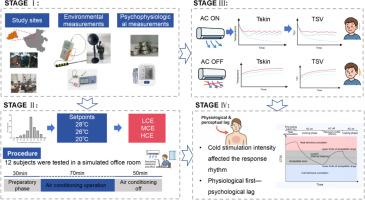非稳态热环境下间歇性降温对人体热生理和感知反应的影响
IF 7.6
1区 工程技术
Q1 CONSTRUCTION & BUILDING TECHNOLOGY
引用次数: 0
摘要
以空调系统的开关循环为特征的间歇性冷却产生了非稳态的室内热环境。虽然被广泛用于节能,但其对人体热生理和感知动力学的影响仍未得到充分了解。为了研究这一点,我们在模拟的住宅/办公空间中进行了室内实验,使用了三个冷却设定点(恒温器目标温度:28°C, 26°C和20°C)。每次试验包括70分钟的主动冷却,然后是50分钟的停机。我们在每个周期中持续监测12名参与者的室内空气温度、皮肤温度、血压、心率和主观热反应。结果表明,冷暴露强度对人体热反应的时间动态有显著影响。在强冷却条件下(20°C),皮肤温度在70分钟内持续下降而不稳定,热感觉和可接受性在35 - 40分钟内保持不稳定,心血管反应(如舒张压、心率)只有在长时间暴露后才被激活,在50分钟后稳定下来。相比之下,适度和弱冷却(26 - 28°C)使大多数生理和知觉反应在15 - 25分钟内稳定下来。各系统之间存在不同步现象:皮肤温度稳定最早,其次是感知反应,而在更强的冷却条件下,心血管调节仍明显延迟。在空调关闭后,在35分钟的过渡时间内,整体恢复发生,在此期间,残余冷暴露的影响继续影响热感知和生理。基于这些发现,我们提出了一个“累积热刺激(CTSI)”指数的理论框架,该指数集成了热偏差和暴露时间,为优化舒适、健康和能源效率的适应性冷却策略提供了定量工具。本文章由计算机程序翻译,如有差异,请以英文原文为准。

Effects of intermittent cooling on human thermophysiological and perceptual responses in a non-steady-state thermal environment
Intermittent cooling, characterized by the on-off cycling of air-conditioning systems, generates a non-steady-state indoor thermal environment. While widely adopted for energy conservation, its impact on human thermophysiological and perceptual dynamics remains insufficiently understood. To investigate this, we conducted chamber experiments in a simulated residential/office space using three cooling set-points (thermostat target temperature: 28 °C, 26 °C, and 20 °C). Each trial involved 70 min of active cooling followed by 50 min of shutdown. We continuously monitored indoor air temperature, skin temperature, blood pressure, heart rate, and subjective thermal responses from 12 participants throughout each cycle. Results show that cold exposure intensity significantly shaped the temporal dynamics of human thermal response. Under strong cooling (20 °C), skin temperature declined continuously without stabilization over 70 minutes, thermal sensation and acceptability remained unstable until 35 - 40 minutes, and cardiovascular responses (e.g., DBP, HR) were only activated after prolonged exposure, stabilizing after > 50 minutes. In contrast, moderate and weak cooling (26 - 28 °C) enabled most physiological and perceptual responses to stabilize within 15 - 25 minutes. Asynchronous was observed among systems: skin temperature stabilized earliest, followed by perceptual responses, while cardiovascular regulation remained notably delayed under stronger cooling. After AC shutdown, overall recovery occurred within 35 minutes transitional time-frame, during which the effects of residual cold exposure continued to influence thermal perception and physiology. Based on these findings, we propose a theoretical framework for a “Cumulative Thermal Stimulus (CTSI)” index that integrates thermal deviation and exposure duration, offering a quantitative tool for adaptive cooling strategies that optimize comfort, health, and energy efficiency.
求助全文
通过发布文献求助,成功后即可免费获取论文全文。
去求助
来源期刊

Building and Environment
工程技术-工程:环境
CiteScore
12.50
自引率
23.00%
发文量
1130
审稿时长
27 days
期刊介绍:
Building and Environment, an international journal, is dedicated to publishing original research papers, comprehensive review articles, editorials, and short communications in the fields of building science, urban physics, and human interaction with the indoor and outdoor built environment. The journal emphasizes innovative technologies and knowledge verified through measurement and analysis. It covers environmental performance across various spatial scales, from cities and communities to buildings and systems, fostering collaborative, multi-disciplinary research with broader significance.
 求助内容:
求助内容: 应助结果提醒方式:
应助结果提醒方式:


